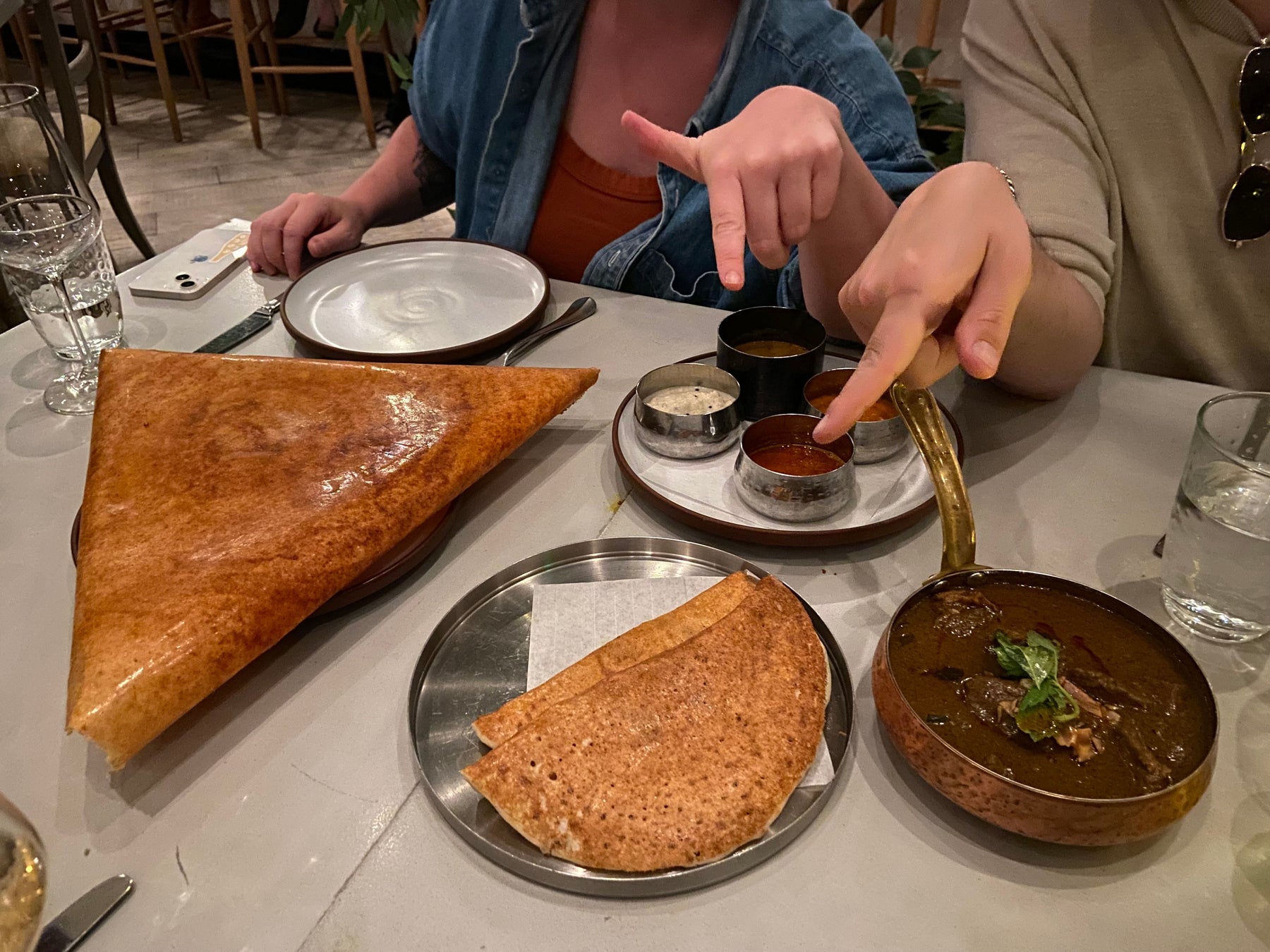
Taste with KJ - Tenmei Meets South Indian Cuisine

When the seasons start to change, we long for food and drink that represent the incoming weather. Nothing says early autumn better than Indian cuisine with its warming spices and comforting chutneys. But what sake to pair with it? The go-to, obvious choice would be something slightly sweet, with fruity aromas to balance the complexity and heat of Indian dishes. But I wanted something even more perfect. I wanted a sake that would not only provide some fruit with a kiss of sweetness, but would enhance umami and respect the depth of the cuisine itself.
I call these sake the ‘straddlers.’ There are only about 2-3 sake in the store that have so much confidence that they straddle both the fruity ginjo realm and the realm of umami savoriness. This style of sake is not for the beginner, but I am always impressed when a customer walks in and asks for one like this. This is the type of sake that Indian cuisine requires and my super straddler for this month’s Taste with KJ is the one year aged, superstar sake Tenmei Junmai Ginjo by Akebono Shuzo in Fukushima.

My original plan was to pair Tenmei with Indian street food from the famous East Bay restaurant Viks Chaat. Open since 1989, they make chaat-style snack food and a multitude of regional dishes. While I did eventually pair my last bit of Tenmei with some items from Viks, I was luckily invited to a night out at Copra, a South Indian restaurant on the fringes of Japantown where I decided to give Tenmei a go. The group of friends I was meeting recently moved to NYC and this was our last hurrah together. This group also included a local industry legend who wanted to say farewell before the big move.
The chance to pair a unique and challenging straddler sake with some of the best palates in the Bay is the heart of this month’s Taste with KJ. Our night out was a great example of how expert foodies combine work and play… enjoying fast conversation, photos of every dish, inquiries to the servers on obscure ingredients and strong opinions on literally everything. This is a photo diary of the evening with the banter only true connoisseurs could muster.
Lucky for us, one of the three beverage experts making their way to NYC was actually working the floor that night, so we were gifted a few special treats. We enjoyed suitcase sake, amongst other things (‘suitcase sake’ is sake that’s been brought over via suitcase from a recent travel to Japan). In this case, it was a Kassei active nigori which continues to ferment slowly in the bottle after it’s released. This style of sake is near impossible to find in the States, so this was an exciting way to begin the meal. The slight bubbles and creamy texture set our palates up for a grand excursion.
We opened the Tenmei next, which was said to have aromas of mushrooms and golden kiwi with a light sweetness and sultry smoothness.

Chutney Palette for the Table
We started with a fantastic array of chutneys, which are sweet or savory relishes made with vegetables and/or fruits with spices and vinegar. They were served with papadum, a crispy cracker made from rice, lentil and/or chickpea flour. They are crunchy and addicting, with a soft flavor coming from the base ingredient. The papadum and the Tenmei were inspiring to us. Someone said, “This sake and cracker are a push and pull handshake. This is a wonderful, dynamic sake.” The chutneys consisted of the pasty textured fermented daikon thogayal with a lentil base, burnt chili and tamarind chutney, the more earthy market kale thogayal and lastly a ghost chili spread.
Tasting with four foodies is no joke. I couldn’t take notes fast enough! The burnt chili and tamarind chutney’s high tartaric acid brightened up the sake and provided much appreciated acid play. The chili heat lasted and the cinnamon spice complemented the sake. Another friend mentioned that Tenmei and papadum was, “a totally enchanting and heavenly pairing. Boy yo yoing!!! This sake has a savory rice custard aroma that tells us this is going to work!”

Perigord Black Truffle Soft Egg Appam
One of the best items of the evening was appam with Perigord black truffles, coconut cream and a soft egg. The thin pancake itself is made with fermented rice batter and coconut milk, further adding to the complexity of this quaint dish. Although our dinner had just started, the group agreed that this was likely to be one of the best pairings of the night. We noticed a probiotic, sour-like yeasty element to the bread that was perfectly accented by the soft egg and truffle flavors. This dish was thin and featherlight, but had an incredible amount of depth and flavor. Tenmei balanced it even more and almost moved with the flavors of the dish, while the dish itself brought out the egg yolk essence of the sake.
A few more captivating small plates arrived. One was called Sweet Corn Mulligatawny, a curry flavored corn soup, this one with mushroom and brown sugar. One of us mentioned that the sake was, “synergetic, with a luscious mouthfeel on par with corn which is not easy to achieve. This sake is quiet and demure. Indian food is tough to pair with sake, but Tenmei does it!”

Rasam Poori
When the Rasam Poori arrived, it was a showstopper. It is the South Indian rendition of the street food pani puri. Rasam is the tangy, spicy soup in which the poori are filled. The little crunchy balls with an indent for cool soup looked like delicate papier-mâché egg morsels ready to be consumed! One of us foodies said, “the beautiful combinations and crunch with the smooth, roasted flavor of the rasam is a good example of WATER having texture.” This dish also paired well with the Kassei live nigori!

Crispy Sambal Peppers

Mysore Masala Dosa
Highlights from the large plates were the epic triangular Mysore Masala Dosa with coconut chutney, tomato chutney, podi, ghee and onion sambar, the Southern Kerala Shrimp Mango Curry and the Crispy Sambal Peppers with pumpkin seeds, coconut, green sambal and cilantro.
At this point, we also had an orange muscat wine from France and a Hungarian white to play with during pairing. For the dosa, we were overwhelmed with how cool it looked, so we didn’t dive into deep tasting notes. As for the spices in the mango curry and the green chili sambal, we had things to say!
“There is a heady mint thing happening. The sake responds in a beautiful way to the carrots and mint. The thing that I come back to with sake is its ability to carry things as if it were a dance partner. Indian is an exciting, vibrant cuisine.” There was a waterpark analogy that came next which was hard to make sense of after the fact... Moving on!
Others said pairing the sake with the peppers left a greener, herbal feeling. It was lifting. There seemed to be a cleansing quality between the freshness of all three beverages on the table and the dishes themselves. Another said, “Sake is the thread to pull you along, while wine is clearing for the next bite… like tennis.”
The sake also became sweeter with the more savory components, like the pumpkin seeds in the sambal peppers. The sake worked very well with the chili peppers, but not as well with the complexity of the spices in the shrimp dish. With the shrimp, the sake brought out its tactile heat. It was almost too much, but the sweetness from the sake emerged here as well.

We had some wine too! The gnome wine is skin-macerated l'Octavin Mus'Cat
Adjacent Insights:
At one point in every Taste with KJ session, the beverage muse will fully take hold. Call it Bacchus or better yet, call it one of your favorite Shinto Sake Gods. Whoever it may be, they begin to call us forth to not only assess sake and the cuisine at hand, but relate them to our life on a spiritual level. The most calm of the group continued to assess Tenmei and had some truly profound words to share. They said, “Tenmei is reminiscent of the hiyaoroshi style or a namazume in general. This sake encapsulates late summer fruit and a feeling of fall spice components.” Another comment that started with praise and ended with sass was, “Tenmei is doing an amazing job and wowing me at how much it can take. It is showing its best with this context and environment, but I would meet sake at the club for dates… Tenmei is not a partner for life.”
More inspiration led to the motto, “ Eat what you’re excited about, drink what you’re excited about and after all that power of post hoc rationalization; just have a good time!”
Also, “Intellect before sensation is natural. But in Japan, sake is fine because they ASSUME it's fine. Nobody is analyzing. There is a beauty about that.”
…And the exclamatory, “The point is to teach people how to fish, not to fish for them. Food and beverage pairings don’t have to be the best. The hunt for Tenmei’s, ‘perfect pairing’ will have to be for another day!”
Moments like these make me wish my body was an everlasting cavern so I can continue to do my work at the utmost extreme level. I want to be a glutton foodie expert extraordinaire! But alas, there are physical restrictions!

Another secret suitcase treat appeared on the table towards dessert and it was akazake, a sake brewed with red ash made famous during the Edo period in Kumamoto Prefecture. This sake was made by Chiyonosono Brewery in collaboration with Orion candy company to represent the cherished days of smoking indoors while enjoying akazake as an after dinner tipple. Candy cigarettes are mostly frowned upon these days due to concerns about kids taking up real smoking, but these were still a hoot.

Other Contenders:
If you are looking for a more classic approach, try Akabu Junmai Ginjo from Iwate or Kameizumi CEL-24 Junmai Ginjo Nama Genshu from Kochi. Both of these have enough sweetness to balance the cuisine's complex spices and exude a bountiful palate of green apple and melon notes. If you want the flavor dialed up a notch, aim for the CEL-24!
If you are like me and prefer sake that can sway between juicy fruit and umami goodness, here are some more super straddlers that get the job done.
Shirayuki Junmai Daiginjo “Winning Horse”: This Hyogo sake is called, “Winning Horse,” because only the best manure from competition winning horses is used to fertilize the rice paddies where the rice for this sake grow! While this sake has vivacious fruit flavors including grape, watermelon and apple candy, it has a smooth texture with a very subtle umami undertone. It almost has a caramel note, but without the sugar. Winning Horse is the perfect sake to explore Indian cuisine with, especially while moving from summer to autumn.
Watanabe Shuzoten Junmai Muroka Genshu 50 “W Aiyama”: This sake from Gifu is unusual in the sense that it’s milled to Daiginjo level (50%) but calls itself a Junmai due to its richer and more umami nature. This sake has the fruity soul of a Daiginjo, but showcases its edgier side as a muroka (unfiltered) and a genshu at 17% abv. The higher abv of this sake will make it harder to pair with some of the spicier elements of Indian cuisine, but the body and bright fruit present will support richer sauces and zesty chutneys.
Do you have a favorite sake with Indian cuisine? Email KJ@truesake.com and you could be featured in our next article. Kanpai!
